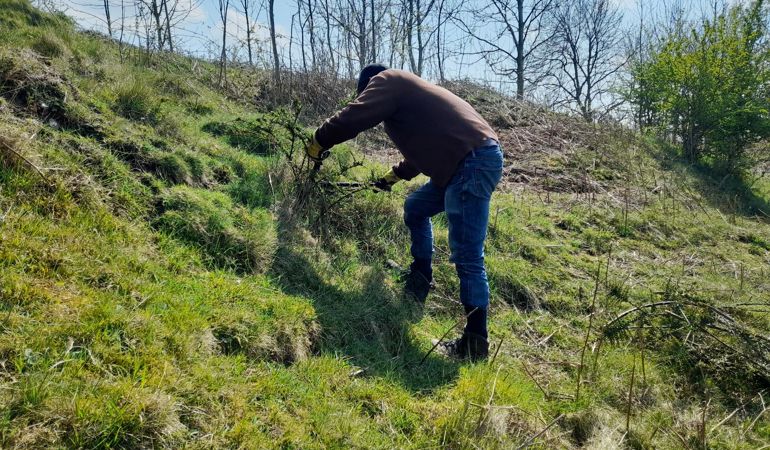Controlling Cotoneaster across North Wales

Back in April, a series of volunteer events got under way to help tackle the invasion of cotoneaster, an invasive non-native species that is causing havoc across North Wales. The first volunteer events took place at Llanddulas and Halkyn SSSIs on 21 and 26 April, whilst other events are being planned for the coming months.
This is part of the ongoing North Wales Cotoneaster Control project that sees Natural Resources Wales Officers work in partnership with the North Wales Wildlife Trust.
Here as part of our coverage for Invasive Species Week 2022, Christina Sheehan, Natural Resources Wales Conservation Officer, tells us more about the project and the challenges posed by this invasive species.
Cotoneaster is a non-native and extremely invasive plant that is spreading and taking over crucial native habitats such as limestone and acid grasslands across North Wales.
It has become a very popular garden shrub and many species have now escaped from gardens and created a huge problem for our protected sites in the region.
The North Wales Cotoneaster Control project helps to identify the spread and abundance of cotoneaster across the region, prioritise protected sites most in need of control and raise awareness of cotoneaster as an invasive non-native species.
Why is cotoneaster a problem?
Brought to the UK in the 19th century as a garden plant, it has now been identified in the top ten species negatively impacting protected sites in Wales, and as a result, it is hugely damaging to our native species of animals, invertebrates, and plants.
If you have cotoneaster in your garden then you may be aware that it attracts bees, birds and other pollinators and in the right place, can seem to benefit wildlife. However, the wind, birds and other animals can spread the seeds and introduce them into the wild where they damage native vegetation and become almost impossible to eradicate. This also results in the loss of food plants for the native species that rely upon them.
Cotoneaster species grow quickly and form rapidly advancing thickets which shade out native species. This is particularly problematic on limestone cliffs, pavements and screes, where many rare native species are found.
If we don’t act, it may cause permanent change to our local landscapes, having devastating effects on wildlife through the loss of species and native food sources.
How can you help?
Native nectar plants offer better quality food sources to a wider range of bird and invertebrate species than non-native cotoneaster, as they are adapted to the local species. If you'd like to attract birds to your garden with berries, better alternatives include Hawthorn, Holly, Honeysuckle, Guelder rose, Dogwood. If you'd like to attract pollinators, try English lavender, scented stocks and wild privet.
Perhaps the most bird-friendly thing you can do is to leave your late-flowering perennials intact until after the worst of the winter. Seed eating birds will feast on the seeds of teasels, asters, sanguisorba’s and various daisies. The twiggy stems and spent flower heads will shelter small insects, and wrens are very fond of frisking through them for food.
Top tips to prevent cotoneaster spreading:
- Treat the exposed stumps with appropriate herbicide;
- Collect all berries (e.g. by placing sheeting underneath the plant when cutting);
- Take the cut material to a disposal centre that deals with non-native invasive species, or safely and completely burn the material.
To find out more about the North Wales Cotoneaster Control project, how you can help our limestone grasslands or to volunteer, you can visit www.northwaleswildlifetrust.org.uk/north-wales-cotoneaster-control.
For further information about invasive species across Wales, please visit https://www.nonnativespecies.org/non-native-species/.
